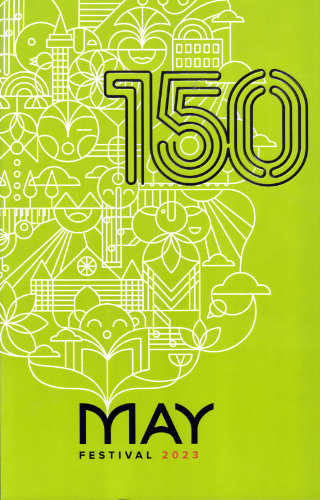 I did better this year than last, and last year I did better than in any of the preceding 148. As explained in a blog post (My First May Fest), by the time I got serious about ending my string of May Festival misses last year, only one of the four major performances fit into my schedule and it was one that would not have otherwise been my first choice. This year I made my move much earlier. My schedule was not yet cluttered and good seats were available for all four performances at Music Hall. I picked the one I did because I like Bach but that’s hardly the date’s only attraction. It was the first of the four main events which made it sort of a May Festival opener. Plus, while Bach’s Magnificat was the big draw, the evening also featured the world premiere of two pieces commissioned for the festival’s 150th anniversary.
I did better this year than last, and last year I did better than in any of the preceding 148. As explained in a blog post (My First May Fest), by the time I got serious about ending my string of May Festival misses last year, only one of the four major performances fit into my schedule and it was one that would not have otherwise been my first choice. This year I made my move much earlier. My schedule was not yet cluttered and good seats were available for all four performances at Music Hall. I picked the one I did because I like Bach but that’s hardly the date’s only attraction. It was the first of the four main events which made it sort of a May Festival opener. Plus, while Bach’s Magnificat was the big draw, the evening also featured the world premiere of two pieces commissioned for the festival’s 150th anniversary.

 The festival program (The front cover of which is pictured up top.) is a real keeper. In addition to details on all of this year’s major performances, it contains plenty of background and history. That history includes the oft-told tale of how thunder, rain, and a leaky tin roof at the second May Festival in 1875 led to the construction of Music Hall in time for the slightly delayed third festival in 1878. Before the festival became an annual event in 1967, it was normally held every two years. A model of the entire Music Hall complex is displayed not far from where I stood to photograph the lobby.
The festival program (The front cover of which is pictured up top.) is a real keeper. In addition to details on all of this year’s major performances, it contains plenty of background and history. That history includes the oft-told tale of how thunder, rain, and a leaky tin roof at the second May Festival in 1875 led to the construction of Music Hall in time for the slightly delayed third festival in 1878. Before the festival became an annual event in 1967, it was normally held every two years. A model of the entire Music Hall complex is displayed not far from where I stood to photograph the lobby.
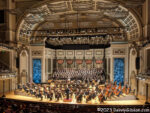 Bach’s Magnificat had its American premiere at that 1875 May Festival as the opener for Beethoven’s Ninth Symphony. This year it was a headliner with the two commissioned works serving as openers. The full May Festival Chorus and Cincinnati Symphony Orchestra were on stage for both new pieces. The Youth Chorus participated in the first piece and the Children’s Chorus participated in the second.
Bach’s Magnificat had its American premiere at that 1875 May Festival as the opener for Beethoven’s Ninth Symphony. This year it was a headliner with the two commissioned works serving as openers. The full May Festival Chorus and Cincinnati Symphony Orchestra were on stage for both new pieces. The Youth Chorus participated in the first piece and the Children’s Chorus participated in the second.
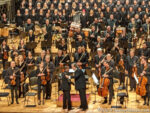

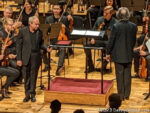 Breaths of Universal Longings was first and at its conclusion, Principle Conductor Juanjo Mena called its composer, James Lee III, on stage to be recognized. Similarly, James MacMillan came on following the performance of his composition, Timotheus, Bacchus and Cecilia. Mena then called Robert Porco, Director of Choruses, to come up. Porco seemed a little reluctant to step into the limelight but did eventually take a bow.
Breaths of Universal Longings was first and at its conclusion, Principle Conductor Juanjo Mena called its composer, James Lee III, on stage to be recognized. Similarly, James MacMillan came on following the performance of his composition, Timotheus, Bacchus and Cecilia. Mena then called Robert Porco, Director of Choruses, to come up. Porco seemed a little reluctant to step into the limelight but did eventually take a bow.
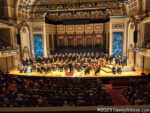 An intermission preceded the Bach composition with fewer performers returning to the stage than had left it. Rather than the 130 or so vocalists of the full chorus, there were now about 50 plus five soloists. I can’t really quantify the orchestra’s reduction with the exception of one section. During the concert’s first half, there had been four percussionists on stage with one of them playing an array of five tympani plus a few other instruments. He was now the lone percussionist with just a pair of smaller tympani at hand.
An intermission preceded the Bach composition with fewer performers returning to the stage than had left it. Rather than the 130 or so vocalists of the full chorus, there were now about 50 plus five soloists. I can’t really quantify the orchestra’s reduction with the exception of one section. During the concert’s first half, there had been four percussionists on stage with one of them playing an array of five tympani plus a few other instruments. He was now the lone percussionist with just a pair of smaller tympani at hand.
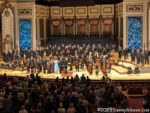 As mentioned, in 1875 Bach had opened for Beethoven. Beethoven’s composition really impressed Cincinnatians but not so Bach’s. One newspaper described Magnificat as “possessing no dramatic character and incapable of conveying the magnitude of the labor that has been expended upon its inconsequential intricacies.” Maybe the current chorus simply did a better job than was done nearly a century and a half ago or maybe it’s just that my taste isn’t as cultivated as that 1875 critic. Whatever the reason, I enjoyed it all. Even the inconsequential stuff.
As mentioned, in 1875 Bach had opened for Beethoven. Beethoven’s composition really impressed Cincinnatians but not so Bach’s. One newspaper described Magnificat as “possessing no dramatic character and incapable of conveying the magnitude of the labor that has been expended upon its inconsequential intricacies.” Maybe the current chorus simply did a better job than was done nearly a century and a half ago or maybe it’s just that my taste isn’t as cultivated as that 1875 critic. Whatever the reason, I enjoyed it all. Even the inconsequential stuff.

 My post on last year’s May Festival visit included a description of dinner at Scotti’s. This year I parked on the Central Parkway side of Music Hall which made Queen City Radio a most convenient spot for dinner. Scotti’s took its name from opera singer Antonio Scotti. Queen City Radio takes its name from former occupants of the building who installed radios in cars in the 1930s before every car came with an integrated multispeaker audio system. The Lübecker food truck currently calls this home and I treated myself to one of the day’s specials, käsespätzle.
My post on last year’s May Festival visit included a description of dinner at Scotti’s. This year I parked on the Central Parkway side of Music Hall which made Queen City Radio a most convenient spot for dinner. Scotti’s took its name from opera singer Antonio Scotti. Queen City Radio takes its name from former occupants of the building who installed radios in cars in the 1930s before every car came with an integrated multispeaker audio system. The Lübecker food truck currently calls this home and I treated myself to one of the day’s specials, käsespätzle.
